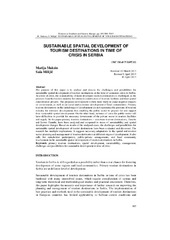Приказ основних података о документу
Sustainable spatial development of tourism destinations in time of crisis in Serbia
| dc.creator | Maksin, Marija | |
| dc.creator | Milijić, Saša | |
| dc.date.accessioned | 2018-12-26T10:58:27Z | |
| dc.date.available | 2018-12-26T10:58:27Z | |
| dc.date.issued | 2013 | |
| dc.identifier.issn | 1848-4050 | |
| dc.identifier.uri | https://raumplan.iaus.ac.rs/handle/123456789/232 | |
| dc.identifier.uri | https://ssrn.com/abstract=2289401 | |
| dc.description.abstract | The purpose of this paper is to analyze and discuss the challenges and possibilities for sustainable spatial development of tourism destinations at the time of economic crisis in Serbia. At a time of crisis, the sustainability of more developed tourism destinations is challenged, as the pressure from the tourism industry for intensive construction of tourism facilities and their spatial concentration prevails. The proposed development is then more likely to cause negative impacts on environment, as well as on social and economic development of local communities. Primary tourism destinations in the initial stage of development do not experience the pressure of tourism industry for intensive development, thus enabling the public sector to prepare for and support their sustainable spatial development. On the other hand, in times of crisis the public sector will have difficulties to provide for necessary investments of the private sector in tourism facilities and supply. In the paper primary tourism destinations - mountain tourism destinations, Danube and Lower Danube, have been analyzed and compared in terms of sustainability and spatial development changes. Based on results of the analyzed cases, the challenges and possibilities for sustainable spatial development of tourist destinations have been evaluated and discussed. The research has multiple implications. It suggests necessary adaptations in the spatial and tourism sector planning and management of tourism destination at different stages of development. It also calls for stakeholder participation, public-private arrangements, and local community involvement in the sustainable spatial development of tourism destinations in Serbia. | en |
| dc.publisher | Univ Rijeka, Faculty Tourism & Hospitality Management, Opatija, Opatija | |
| dc.rights | openAccess | |
| dc.source | 2nd International Scientific Conference Tourism In Southern and Eastern Europe 2013: Crisis - A Chal | |
| dc.subject | primary tourism destinations | en |
| dc.subject | spatial development | en |
| dc.subject | sustainability | en |
| dc.subject | management | en |
| dc.subject | challenges and possibilities for sustainable development in time of crisis | en |
| dc.title | Sustainable spatial development of tourism destinations in time of crisis in Serbia | en |
| dc.type | conferenceObject | |
| dc.rights.license | ARR | |
| dcterms.abstract | Максин, Марија; Милијић, Саша; | |
| dc.citation.volume | 2 | |
| dc.citation.spage | 185 | |
| dc.citation.other | 2: 185- | |
| dc.identifier.wos | 000323235000014 | |
| dc.identifier.fulltext | https://raumplan.iaus.ac.rs//bitstream/id/793/SSRN-id2289401.pdf | |
| dc.identifier.rcub | https://hdl.handle.net/21.15107/rcub_raumplan_232 | |
| dc.type.version | publishedVersion |

